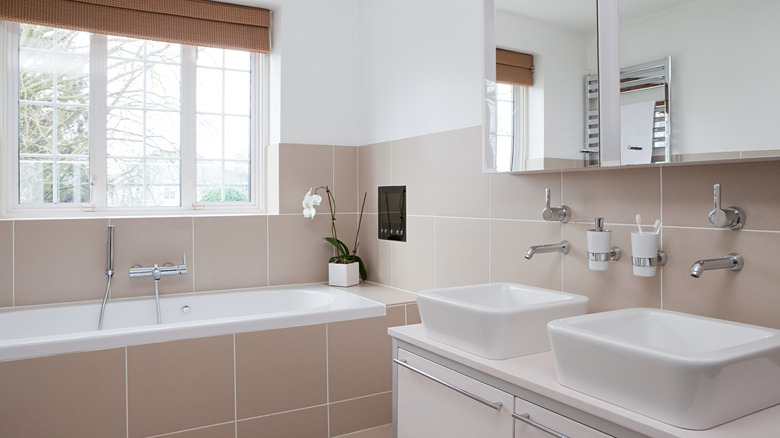TikTok's De-Influencing Trend Is A Breath Of Fresh Air - But It's Nowhere Near Perfect
As TikTok has expanded in popularity, it has grown to reach seemingly every niche. Whether you turn to the platform for tips on fashion, organization, or sustainability, there seems to be hours of content ready to keep you entertained. The one thing that all of these topics have in common, however, is their propensity to introduce TikTok users to new products or hacks that are pitched as "life-changing."
While viewers attempt to recreate the aesthetic routines of their favorite influencers, content creators are only too happy to provide shopping lists of their most-used products. A classic example of this promotional content can be found in the likes of a Miriam Gin "Amazon Favorites" video. One upload, which was already "part 15" in the series, garnered over 1.5 million likes.
This consumption-focused trend, alongside traditional "sponsored" content from influencers, has led to intense pressure to buy, buy, buy. It has also inspired a response to the culture: anti-influencing. It's fresh, it's trendy, and it's ... flawed.
De-influencing offers honest reviews of hot products
"TikTok made me buy it" is becoming a popular refrain, no matter the market you're shopping in. Businesses like Barnes & Noble and Ulta have taken advantage of the platform's selling capacity, assembling displays of "TikTok's Favorite Products." Whether it's Colleen Hoover's latest release or Olaplex shampoo, TikTok creators have become unpaid experts at peddling the latest hit. De-influencing emerged to disrupt that trend.
"Let me de-influence you," says influencer Valeria in a video that's been viewed nearly 900,000 times. She launches into an account of her personal experiences with viral TikTok products, seeking to "de-influence" her followers out of buying them. In a classic example of this latest trend, Valeria hopes to save her followers money and protect them from ultimately disappointing goods. According to these creators, some TikTok advice is not worth listening to.
In a conversation with Time, a TikTok influencer by the name of Grey talked about her passion for de-influencing. "It makes the value of a true recommendation that comes from the heart so much more powerful, rather than me just pedaling out a salad spinner or the latest lipstick." Many have also noticed that this is far from the only benefit.
Many see the trend as a response to over-consumption
In a collaboration between the @impact and @environment trends on Instagram, de-influencing was praised as a way to preserve the environment and your wallet. The post noted that any move toward lower consumption helps to foster a more habitable ecosystem for humans and animals around the world.
Praise for the trend has also been echoed on platforms like Twitter. "As a victim of mid-2010's beauty youtube, this new de-influencing trend is extra comforting me," said one user. Even those who don't plan to stop shopping were able to find some positivity in the trend: "Please keep de-influencing so I can actually start finding all the Charlotte Tilbury products ... back in stock again!"
Of course, it's hard to find a TikTok trend that the entire internet can agree to love. Just as quickly as de-influencing exploded into popularity, some people began poking holes in the theory that it's a solution to over-consumption.
Many creators offer affiliate-backed alternatives
The anti-consumption angle of de-influencing falls apart when creators choose to offer alternatives to TikTok's golden products. Some creators' approach to the trend has involved offering product alternatives, and viewers are catching on to the irony. "[T]he 'de-influencing' trend on TikTok [is] crazy because it's turned into 'buy this not this' ... like it's literally just regular influencing," wrote one Twitter user.
Indeed, some influencers offer "dupes" to expensive, popular items. The trick is that many of these product alternatives can be purchased via an affiliate link, which offers a financial incentive for video creators to persuade their audiences to make the switch. Through Amazon or platforms like LTK, influencers can link out to their favorite products and earn a commission on their followers' subsequent purchases. According to Insider, some influencers reported earning upwards of $25,000 per month through these efforts.
Alyssa Stephanie, a popular TikTok creator with an Amazon storefront linked in her bio, created a de-influencing, "buy this, not that" style video which garnered over 700,000 likes. After a closer examination of the trend and a conversation with Alyssa herself, Insider went on to denounce "de-influencing" as a bit of a contradiction.
De-influencing may not last
Alongside the dubious trustworthiness of the trend's leading de-influencers, some have speculated that the videos' popularity is a fleeting consequence of our current economic conditions. Centennial Beauty likened "de-influencing" trends to "anti-haul" content that has previously emerged during times of financial hardship.
For some, the determination to save money and de-clutter are highly reminiscent of 2008 and the COVID-19 pandemic. "I love cool recession trends," one Twitter user quipped in response to the hot topic. There's also a chance that de-influencing's rapid rise could have been aided by the time of year that it emerged.
As TikTok users attempt to get their 2023 off to a good start, it's reasonable that many have goals and resolutions related to saving money. The popularity of "no buy month" content and the emergence of #DebtTok has introduced frank conversations about financial freedom and overconsumption. However, New Year's resolutions have a tendency to fall off track as the months' progress.
How to reduce TikTok's culture of consumption
If you're hoping to cut down on consumption, de-influencing may not be the perfect solution it poses as. In fact, although TikTok is packed with motivational videos and money-saving content, the platform itself may serve as too much of a temptation for big shoppers.
Still, if you're not ready to give up TikTok and overspending, try tapping into trends like "cash stuffing" and anti-hauls. The former focuses on setting aside money from paychecks into envelopes designated with certain dollar amounts. With a certain amount stuffed away each week, you're destined to end up with a stack of savings at the end of the year.
Other users have found success in adding tempting items to an Amazon cart and reviewing the potential purchases at the end of each month. With some time and distance from the recommendations, you can then eliminate the items that have lost their appeal and cut down on your final total. Above all, remember that you don't need to spend money or follow the latest trends to live a full life. In fact, making the most of what you already have will help to save you time, and money, and protect the Earth we all love so much.





